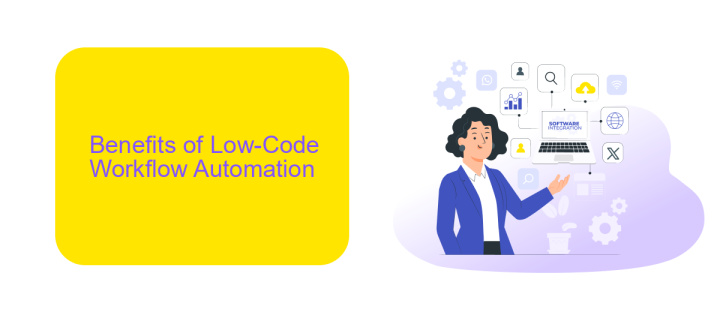Low Code Workflow Automation
In today's fast-paced business environment, Low Code Workflow Automation is revolutionizing how organizations streamline their processes. By enabling users to design and implement workflows with minimal coding, this approach significantly reduces development time and costs. As a result, companies can quickly adapt to changing needs, improve efficiency, and maintain a competitive edge in the market.
Introduction
Low Code Workflow Automation is transforming the way businesses operate by streamlining processes and reducing the need for extensive coding knowledge. This approach allows organizations to quickly develop and deploy workflows, saving time and resources while enhancing productivity.
- Reduces dependency on IT departments
- Accelerates time-to-market for new processes
- Improves collaboration across teams
- Enables easy integration with existing systems
One of the key advantages of low code automation is the ability to integrate various services seamlessly. Platforms like ApiX-Drive enable businesses to connect different applications effortlessly, ensuring smooth data flow and operational efficiency. By leveraging such tools, organizations can focus on their core activities while maintaining a high level of automation and integration.
Benefits of Low-Code Workflow Automation

Low-code workflow automation offers numerous benefits, primarily by significantly reducing the time and resources required for application development. This approach allows non-technical users to create and modify workflows with minimal coding knowledge, thereby empowering teams to respond quickly to changing business needs. By streamlining processes and eliminating manual tasks, organizations can improve efficiency, reduce errors, and enhance overall productivity.
Moreover, low-code platforms often come with built-in integration capabilities, making it easier to connect various applications and services. For example, ApiX-Drive enables seamless integration between different software solutions, allowing businesses to automate data transfers and synchronize information effortlessly. This not only speeds up the implementation process but also ensures that all systems work harmoniously together, providing a unified and efficient workflow environment. By leveraging low-code automation, companies can stay agile, innovate faster, and maintain a competitive edge in the market.
How Low-Code Workflow Automation Works

Low-code workflow automation simplifies the process of creating and managing workflows through a visual interface, reducing the need for extensive coding. This approach enables businesses to streamline operations and improve efficiency with minimal technical expertise.
- Identify the workflow process that needs automation.
- Use a low-code platform to design the workflow visually, dragging and dropping elements as needed.
- Configure the necessary integrations with other systems and applications. Services like ApiX-Drive can facilitate these integrations seamlessly.
- Test the workflow to ensure it operates as expected.
- Deploy the automated workflow and monitor its performance, making adjustments as necessary.
By leveraging low-code platforms, organizations can quickly adapt to changing business needs without relying heavily on IT departments. This democratizes the automation process, allowing non-technical users to contribute to workflow optimization and ultimately drive greater productivity.
Challenges of Low-Code Workflow Automation

Low-code workflow automation offers numerous benefits, but it also comes with its own set of challenges. One of the primary issues is the limited customization options. While low-code platforms are designed to be user-friendly, they may not offer the same level of flexibility as traditional coding methods, making it difficult to tailor solutions to specific business needs.
Another challenge is the integration with existing systems. Many businesses rely on a variety of software and tools, and ensuring seamless integration can be complex. Although services like ApiX-Drive can simplify this process by providing pre-built connectors and easy integration options, there may still be limitations in terms of compatibility and performance.
- Lack of deep customization
- Integration complexities
- Scalability issues
- Security concerns
Additionally, scalability can be a concern. As businesses grow, their workflow automation needs become more complex, and low-code platforms may struggle to keep up. Security is another critical issue, as low-code solutions may not offer the same level of protection as custom-coded applications, potentially exposing sensitive data to risks.
Conclusion
In conclusion, Low Code Workflow Automation offers a transformative approach to streamlining business processes. By reducing the need for extensive coding expertise, it empowers teams to create, modify, and manage workflows more efficiently. This democratization of technology not only accelerates project timelines but also fosters innovation within organizations. The ability to rapidly prototype and deploy solutions ensures that businesses can adapt to changing market demands with agility and precision.
Furthermore, integrating services like ApiX-Drive can significantly enhance the capabilities of low code platforms. ApiX-Drive facilitates seamless connections between various applications, enabling automated data transfer and synchronization. This integration capability ensures that workflows are not siloed but interconnected, providing a holistic view of operations. As businesses continue to embrace digital transformation, the synergy between low code automation and robust integration tools like ApiX-Drive will be pivotal in achieving operational excellence and sustained growth.


FAQ
What is Low Code Workflow Automation?
How can Low Code Workflow Automation benefit my business?
Is it necessary to have programming skills to use Low Code Workflow Automation platforms?
What types of processes can be automated using Low Code Workflow Automation?
How do I integrate Low Code Workflow Automation with my existing systems?
Routine tasks take a lot of time from employees? Do they burn out, do not have enough working day for the main duties and important things? Do you understand that the only way out of this situation in modern realities is automation? Try Apix-Drive for free and make sure that the online connector in 5 minutes of setting up integration will remove a significant part of the routine from your life and free up time for you and your employees.

